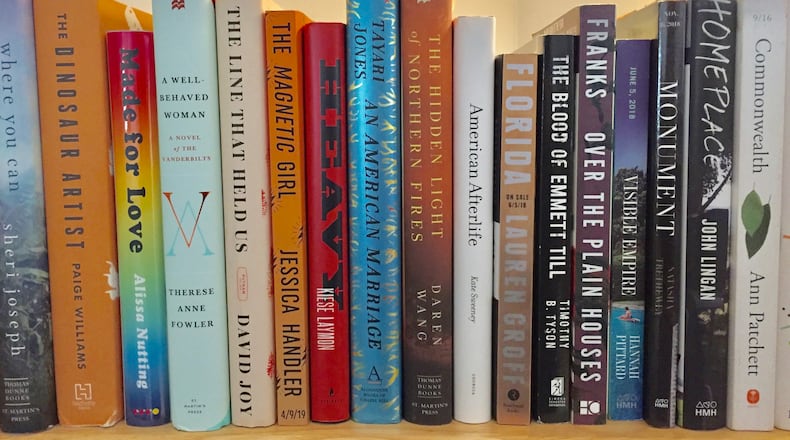In 1999, Amadou Diallo, an immigrant from Guinea, was shot 41 times by four New York City police officers without provocation. Since then, this fate has been shared by Eric Garner, Sandra Bland, Philando Castille, Tamir Rice, Stephon Clark and others. Devi S. Laskar's timely debut novel, "The Atlas of Reds and Blues," is a poignant meditation on racism and police brutality experienced by people of color.
Laskar’s protagonist, Mother, is the American-born daughter of Bengali immigrants. She lives an ordinary life in an Atlanta suburb with her white husband, Hero, who travels for his job, and their three daughters, Eldest, Middle and Youngest. Hero’s insistence that suburbia will provide the best upbringing for their daughters is challenged by the racism they face in the American South. One morning the unthinkable happens when police raid their house, and Mother finds herself in her driveway with assault weapons pointed at her. The incident births the entirety of the novel as she recalls in a burst of memories her life and choices leading to this particular moment.
It would be remiss not to mention that Laskar herself faced a similar ambush while living in an Atlanta suburb. That she has based her novel on her experience certainly lends it more gravitas, however, why not write a memoir? Perhaps some traumas can only be dealt with through imaginative and fictive distance. Laskar also makes the unusual choice to not name her characters. While this runs the risk of keeping the reader at arm’s length, it also elevates the narrative from being merely one person’s story into a universal fable where these characters are everyone and anyone. Whether you appreciate this choice or not will depend on the sort of reader you are.
The same is true of the fragmentary nature of the narrative. Laskar has several poetry collections to her credit, and her poetic sensibility is evident in her narrative style. “The Atlas of Reds and Blues” is a collage of short chapters juxtaposed with chapters comprised of just one line. Where the lengthier chapters serve to flesh out relationships, the single-sentence chapters deliver maximum thematic impact. For instance, “An agent turns on the siren of his squad car, just for fun,” deftly conveys the full depth of menace and threat. Although Mother’s non-chronological recollections can be hard to keep straight, they also splendidly mirror the muddle that is a memory “racing through time.” Part of the pleasure of reading “The Atlas of Reds and Blues” is figuring out the many threads connecting these kaleidoscopic memories.
Laskar eschews the poet’s pen in lieu of stripped down, bare prose. This is a fitting style to illustrate that there is nothing pretty or poetic about lying helpless on your driveway at the mercy of joking, trigger-happy cops while indifferent neighbors go about their day. When Laskar does indulge in linguistic pyrotechnics, the effects are all the more striking and often reference the colors in the book’s title. “On the driveway her thirst is primitive: She wants to taste the blue palette of cold water, she wants to dispel the rancid ketchup taste blooming in her mouth.”
Laskar has a fine eye for capturing the loneliness and heart break of her characters, even as they desperately try to assimilate. Despite Mother’s attempts to fit in, she is constantly asked where she is from. It is to Laskar’s credit that she does not shy away from the ugliness of identity politics in an America where being born here is never enough to be considered American, or the debilitating mental health costs of residing in hostile neighborhoods. Laskar goes a step further to show that emotional assaults come not only from strangers but also from loved ones. At one point, after lightening strikes their house and they can’t shut their garage door, the neighbors duct tape yet another nasty letter to their front door. Mother wants to sue, but Hero says softly, “We have to be nice … We agreed to follow their rules when we moved here.”
Many of the most riveting scenes in “The Atlas of Reds and Blues” are the racial and gender violations that take place in what should be safe places such as a grocery store, a laundromat, a doctor’s clinic, the school and the newspaper office where Mother worked as a journalist. It is devastating to watch the daughters come to terms with the America they live in. “‘Just think of it as a game,’ (Mother) tells the Middle Daughter, who is crying in the backseat, because she wasn’t invited to her classmate’s birthday party. Everyone else came to school on Monday wearing the tie-dye T-shirt they’d made over the weekend. ‘What game is that? Pick on the girl who looks different?’”
The most affecting parts of this novel are devoted to Greta, the abused German Shepherd Mother adopts. We see Greta lose her puppies, Greta as a middle-aged companion, Greta as elderly and ill Greta, all culminating in memories of Greta’s ghost flooding Mother as she lies defenseless on her driveway. It is in fact Greta’s one act of ferociousness that will allow Mother the courage for her own rebellion.
“The Atlas of Reds and Blues” provides no easy answers. It does, however, delve deeply into the plight of ordinary people who do nothing to invite hate and yet get caught in hatred’s web, only to find disentanglement almost impossible. Laskar’s fine and moving novel is a step toward her own release, and with it she simultaneously offers readers a way out, too.
FICTION
‘The Atlas of Reds and Blues’
by Devi S. Laskar
Counterpoint Press
272 pages, $25
About the Author
Keep Reading
The Latest
Featured




